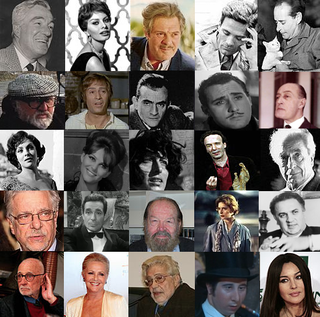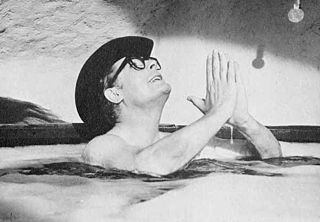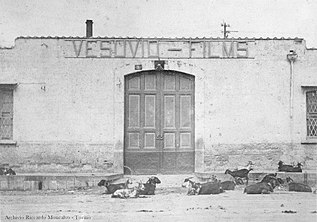
The cinema of Italy comprises the films made within Italy or by Italian directors. Italy is one of the birthplaces of art cinema and the stylistic aspect of film has been one of the most important factors in the history of Italian film. As of 2018, Italian films have won 14 Academy Awards for Best Foreign Language Film as well as 12 Palmes d'Or, one Academy Award for Best Picture and many Golden Lions and Golden Bears.

Vittorio De Sica was an Italian film director and actor, a leading figure in the neorealist movement.

Naples is the regional capital of Campania and the third-largest city of Italy, after Rome and Milan, with a population of 909,048 within the city's administrative limits as of 2022. Its province-level municipality is the third-most populous metropolitan city in Italy with a population of 3,115,320 residents, and its metropolitan area stretches beyond the boundaries of the city wall for approximately 30 kilometres.

Antonio Griffo Focas Flavio Angelo Ducas Comneno Porfirogenito Gagliardi De Curtis di Bisanzio, best known by his stage name Totò, or simply as Antonio de Curtis, and nicknamed il principe della risata, was an Italian actor, comedian, screenwriter, dramatist, poet, singer and lyricist. He is commonly referred to as one of the most popular Italian performers of all time. While best known for his funny and sometimes cynical comic characters in theatre and then many successful comedy films made from the 1940s to the 1960s, he also worked with many iconic Italian film directors in dramatic roles.

Neapolitan is a Romance language of the Italo-Romance group spoken in Naples and most of continental Southern Italy. It is named after the Kingdom of Naples, which once covered most of the area, since the city of Naples was its capital. On 14 October 2008, a law by the Region of Campania stated that Neapolitan was to be protected.

Eduardo De FilippoOMRI, also known simply as Eduardo, was an Italian actor, director, screenwriter and playwright, best known for his Neapolitan works Filumena Marturano and Napoli Milionaria. Considered one of the most important Italian artists of the 20th century, De Filippo was the author of many theatrical dramas staged and directed by himself first and later awarded and played outside Italy. For his artistic merits and contributions to Italian culture, he was named senatore a vita by the President of the Italian Republic Sandro Pertini.

Elvira Notari was an Italian film director, one of the country's early and more prolific female filmmaker. She is credited as the first woman who made over 60 feature films and about 100 shorts and documentaries, quite often writing the subjects and screenplays, inspired by Naples. The Elvira Notari Prize is named after her.

Commedia all'italiana, or Italian-style comedy, is an Italian film genre born in Italy in the 1950s and developed in the 1960s and 1970s. It is widely considered to have started with Mario Monicelli's Big Deal on Madonna Street in 1958, and derives its name from the title of Pietro Germi's Divorce Italian Style (1961). According to most of the critics, La Terrazza (1980) by Ettore Scola is the last work considered part of the commedia all'italiana.

The Gold of Naples is a 1954 Italian anthology film directed by Vittorio De Sica. It was entered into the 1955 Cannes Film Festival. In 2008, the film was included on the Italian Ministry of Cultural Heritage’s 100 Italian films to be saved, a list of 100 films that "have changed the collective memory of the country between 1942 and 1978."

Tina Pica was an Italian supporting actress who played character roles on stage. Her film debut came in 1935 with The Three-Cornered Hat.

The Four Days of Naples was an uprising in Naples, Italy, against Nazi German occupation forces from September 27 to September 30, 1943, immediately prior to the arrival of Allied forces in Naples on October 1 during World War II.

Anna Campori was an Italian actress. From 1951 onwards, she appeared in 70 films.

Guappo is a historical Italian criminal subculture and informal term of address in the Neapolitan language, roughly analogous to or meaning thug, swaggerer, pimp, braggart, or ruffian. While today the word is often used to indicate a member of the Camorra, a Mafia-type organisation in the region of Campania and its capital Naples in Italy, the guapperia predates the modern Camorra and was originally a different and separate criminal subculture that considered itself very much independent of the Camorra.

Attilio Pratella was an Italian painter, noted for his landscapes and realistic scenes of Neapolitan life.

The sceneggiata or sceneggiata napoletana is a form of musical drama typical of Naples. Beginning as a form of musical theatre after World War I, it was also adapted for cinema; sceneggiata films became especially popular in the 1970s, and contributed to the genre becoming more widely known outside Naples. The most famous actors who played dramas were Mario Merola, Mario Trevi, and Nino D'Angelo.

The list of the 100 Italian films to be saved was created with the aim to report "100 films that have changed the collective memory of the country between 1942 and 1978". Film preservation, or film restoration, describes a series of ongoing efforts among film historians, archivists, museums, cinematheques, and non-profit organizations to rescue decaying film stock and preserve the images they contain. In the widest sense, preservation assures that a movie will continue to exist in as close to its original form as possible.

Fiorenza Calogero is an Italian world music singer and actress from Naples, Italy.

Lina Mangiacapre was an Italian feminist playwright and filmmaker.

The Colli Aminei are an area of Naples, Italy, that is part of the municipality of Stella-San Carlo at the Arena, specifically of the Stella district. It is bordered to the west and north by the Vallone di San Rocco, to the east by the Capodimonte ascent, to the south by the valleys of the Scudillo and the Fontanelle.
Naplesis a 1898 silent documentary short shot of Naples by the Lumière Brothers. The film played and important role for the history of Neapolitan cinema, being one of the first if not the first shot at Naples on video, while also being one of the first films shot by the Lumière Brothers.



























